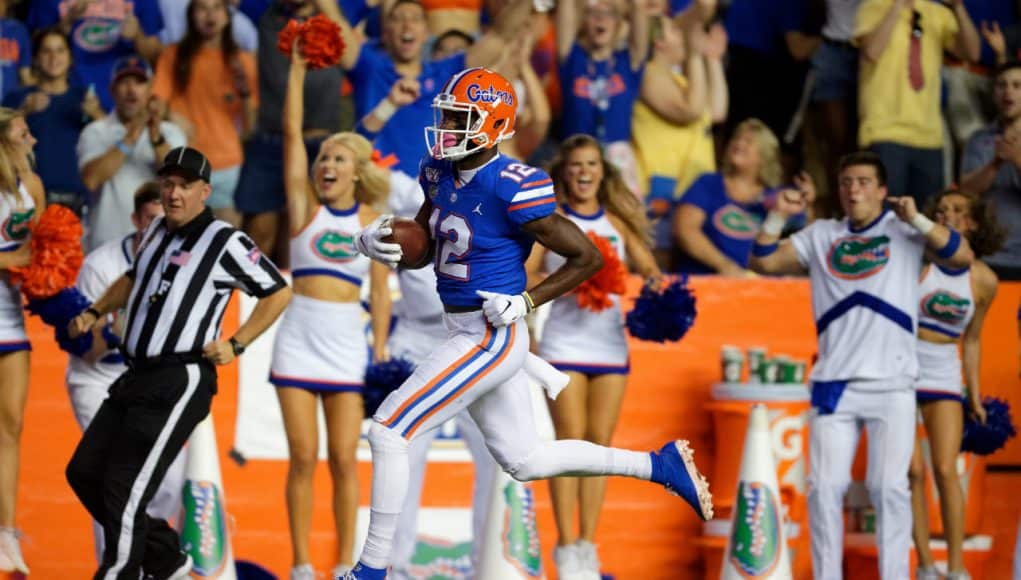The Florida Gators’ rushing game has struggled early in 2019. Primary running back Lamical Perine is under four yards per carry on the year. Backup Malik Davis is under three, while Dameon Pierce has been at or below four yards per run in three of the five games.
Inconsistent blocking from the offensive line and tight ends is the primary reason for the problems. Dan Mullen has experimented with playing Richard Gouraige at both guard and tackle to see where improvement might come, but the results until last weekend were inconclusive.
Even though things were better with Gouraige at left guard against Towson, the baseline was so low that “clearly improved” doesn’t necessarily equal “good”. And with some of the toughest fronts Florida will face all year in the next few games, there’s no time left to wait for the new lineup to get seasoning through experience.
Therefore, Mullen has been using his embarrassment of riches at wide receiver to augment the run game. Wideouts have been taking handoffs more often than in the past, and the quarterbacks have used “extended run” plays like screens and swing passes to fill in for the ailing rushing attack.
Here are some of the ways that the Gators have gone about it.
Under center screens
From the first game against Miami, Florida has gone under center more often than you’d expect a spread offense to do. That’s just a look Mullen wanted to use this year, I guess. They do a lot of running from it, though they’ve worked play action as well.
Against Towson, Florida ran quick screens to the outside three times from under center. The targeted receiver had another wideout ahead of him to be the lead blocker. The first two times were to Trevon Grimes with either Van Jefferson or Tyrie Cleveland blocking for him. The third was towards the end when Jacob Copeland had Trent Whittemore blocking for him.
The idea here is to have the tendency of running from under center bringing the defense in close and then popping it to relatively clear space outside the hash. Two of the three times were in short yardage situations, and the Gators’ physical receivers picked up the conversion each time.
Swing passes
These are another way to get the ball to the perimeter quickly to avoid having the poor run blocking up front affect plays. Perine has gotten a few of these, though his yards per catch rate on the season of 5.6 tells you that defenses have been ready for them.
Josh Hammond got a couple of them last weekend. He got one going to the edge on 2nd & 3 in the red zone and had two receivers and Perine split out wide to be blockers for him. He got the needed yardage. Again, the Gators got the ball out from behind the offensive line as quickly as possible to convert short yardage.
He also motioned a fair distance behind Kyle Trask on a 3rd & 6, and the defense didn’t bother to adjust. Trask threw it right to Hammond with no one around, and he made a move on a defender near the first down line to pick up the conversion.
Motion receivers to two-back sets
A club that Mullen pulled out of the bag in Week 2 against UT-Martin was motioning a receiver to the backfield that already had a running back in it to create a two-back look. More often than not, the receiver would take the handoff and run a sweep to the outside with the running back serving as a lead blocker.
Kadarius Toney was the first guy to get the handoff on this tactic, but then he went down in that game. Afterwards they faked it to Hammond on the touchdown where UTM didn’t cover Cleveland, and then Copeland, who has more or less been filling in for Toney, got a handoff late. Whether it was due to Toney’s injury, Feleipe Franks’s injury the next week, both, or something else, Florida didn’t use this motion again until last weekend against Towson.
The results on this one have been mixed. You can see in the video above that only one of these handoffs resulted in a big gain. It’s not hard to guess why. Receivers don’t typically motion to the backfield in this way, so if one does, it’s probably to be the focus on the play. Mullen can work with that, as seen by the play action to Cleveland or backside rollout motion for Trask and Grimes against Towson. Setting the defense’s expectation is useful since you can run moves counter to it later.
The rest
The Gators have run a reverse twice, once against Tennessee and again against Towson. They came from different formations and attacked the short and wide side of the field once each, so there isn’t an obvious tell for it yet.
The Gators have gone to the jet sweep some as well. Hammond took one 76 yards to ice the Kentucky game.
Through five games, UF wide receivers have just above half as many carries (12) as they collectively did in 13 games last year (23). Toney got all but two of them a year ago, with Hammond getting the rest. Hammond already has that beat with three this year. The rate of wide receiver runs may even increase later once Toney returns from injury.
Florida has to stick with some traditional runs because that’s what Mullen’s offense is built on. It also sets up some passes as I discussed above. Maybe the run game will open up more with Gouraige in. We’ll see.
In the meantime, Mullen isn’t standing still on the issue. He’s turned to his wide receivers to take handoffs and receive quick screens and swings to fill in for issues running between the tackles. It’s likely he’ll need to use all these tricks and more against a scary Auburn front this weekend.


